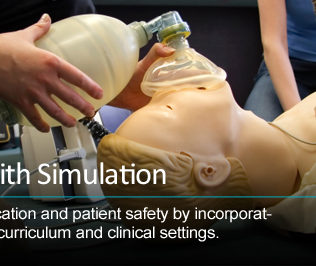Debriefing Medical Simulation Using Good Judgment with UW Template
Healthcare simulation has become an integral part of medical education and ongoing clinical skill development. Debriefing is considered by many to the most important component of medical simulation since debriefing involves a period of time where learners review their frames of reference, reflect on their actions and propose changes for future practice. According to Kolbe, experience alone limits the development of clinical expertise however, the addition of careful reflection, facilitates expert practice. Today’s article on using good judgment in debriefing was guest authored by Dr. Kim Baily PhD, MSN, RN, CNE, previous Simulation Coordinator for Los Angeles Harbor College and Director of Nursing for El Camino College. Over the past 16 years Kim has developed and implemented several college simulation programs and previously chaired the Southern California Simulation Collaborative.
Debriefing is a skill that must be studied, practiced and reflected upon. Many educators, particularly those new to debriefing, find debriefing a challenge because they are afraid of intimidating or embarrassing learners. However, simply commenting on learner’s actions, does not help the learner discover what led them to make a particular decision – in other words discover their frames of reference. Without this step, learners will not be able to reframe their assumptions and will have difficulty making changes to future practice.
Debriefing with Good Judgment is a debriefing theory developed by Rudolph, Simon, Dufresne and Raemer in 2006. The method is based on the idea that learners must reflect on their own actions to identify existing work practices/routines and their own assumptions. Without such self-review, learners are closed to changes and thus may continue with ineffective habits.
Sponsored Content:
The method has three main components:
- Learners make clinical actions and decisions based on frames which are in turn based on the learner’s knowledge, assumptions and feelings.
- By discovering the learners internal frame, the instructor can help the learner “reframe” – this prompts the learner to make changes in future practice
- The instructor uses inquiry to determine the learners’ frames of reference. The authors describe the role of the instructor as a “cognitive detective”.
- Learners’ actions are considered to be a series of puzzles to be solved rather than the identification of a list of errors.
- A discussion occurs where the instructor makes “constructive observations and subjective judgements” about the learners’ actions.
- This step is considered to be advocacy.
- The instructors own frames of reference are examined as part of the discussion. This ensures that the debriefing is nonthreatening.
Note that debriefing with good judgement is not the same as:
- A judgmental approach to debriefing. The instructor does not ask “what went wrong here” or “what is the obvious mistake”. This is a shame-and-blame approach which leads to embarrassment and an unwillingness of learners to either participate in the activity.
- Nonjudgmental debriefing. This method involves a softening of a criticism sandwiched between two compliments. Body language and tone may convey a message to the learner that the instructor is right and the learner has made an error. This in turn may prevent the open discussion of mistakes.
- Debriefing with Good Judgment identifies a context for adult learners as well as the learner frames of reference, assumptions and knowledge.
- The process involves an open sharing of opinions and assumes that the learners are seeking to do the best they can.
- The instructors’ frames of reference are included as a method to induce dialogue.
- The process involves an open sharing of opinions and assumes that the learners are seeking to do the best they can.
- The expert opinion of the instructor and the insights of the learner are both valued.
When the instructor has serious concerns about a learners’ clinical skills, the instructor should follow up in a post debriefing session.
Download the UW Debriefing Template Here!
There are more great tips below, but do you have a debriefing template to share with the world? Submit yours here or email us!
Sponsored Content:
Hints for debriefing with good judgment:
- Statements such as “help me understanding why you …….” or “Given my perspective, this seems unclear: what am I missing?”. Download the University of Washington instruction sheet above for this method of debriefing.
- The authors gave several occasions when debriefing with good judgment might not work:
- In rare cases where the learner is deliberately acting malevolently.
- When learners come from cultures that pay great respect to people in authority. These learners may be unwilling to share their views as their actions may be construed as disrespectful.
Staff may be reluctant to report errors or near misses because of fear of reprisals. Improving patient safety involves as many strategies as possible to train staff and identify areas of practice where errors have occurred or are likely to occur. Medical Simulation provides an ideal platform for both identifying potential medical errors, providing training for known errors and where there is absolutely no risk of patient harm. In addition, medical simulation needs to be conducted in an environment where the learners feel respected and safe. Debriefing with good judgment provides a method for learners to reflect on their own frame of reference while at the same time being supported and being treated respectfully.
Further Reading: Theories and Styles of Debriefing: the Good Judgment Method as a Tool for Formative Assessment in Healthcare (José M. Maestre, Jenny W. Rudolph)
Despite its importance, debriefing is a dilemma for many instructors because they often cannot find ways to openly express their critical judgments about observed clinical performance without hurting their colleagues’ feelings or making them defensive. As a result, instructors often fail to verbalize their thoughts and feelings to avoid confronting, challenging, or provoking negative emotions in their colleagues with the aim of maintaining a good working relationship with them. This feedback dilemma is resolved by helping the professional to elicit the highest standards of performance from the trainees while holding them in the highest personal regard.
Debriefing is an effective strategy for formative assessment (during learning) and professional development. Inquiry is used to reveal the frames that explain the difference between the expected and the observed clinical performance (which may be positive or negative). It enables specific feedback to be given that is adapted to the trainees’ individual needs and helps them to develop new frames that will allow them to develop new and more effective actions in similar clinical situations in the future. Read the full article here.
Subscribe to HealthySim’s Free Newsletter for More Great Debriefing Tips!
Have a story to share with the global healthcare simulation community? Submit your simulation news and resources here!
Dr. Kim Baily, MSN, PhD, RN, CNE has had a passion for healthcare simulation since she pulled her first sim man out of the closet and into the light in 2002. She has been a full-time educator and director of nursing and was responsible for building and implementing two nursing simulation programs at El Camino College and Pasadena City College in Southern California. Dr. Baily is a member of both INACSL and SSH. She serves as a consultant for emerging clinical simulation programs and has previously chaired Southern California Simulation Collaborative, which supports healthcare professionals working in healthcare simulation in both hospitals and academic institutions throughout Southern California. Dr. Baily has taught a variety of nursing and medical simulation-related courses in a variety of forums, such as on-site simulation in healthcare debriefing workshops and online courses. Since retiring from full time teaching, she has written over 100 healthcare simulation educational articles for HealthySimulation.com while traveling around the country via her RV out of California.
Sponsored Content:




















